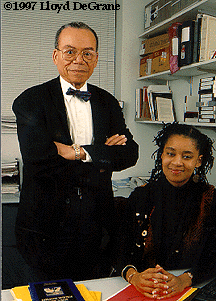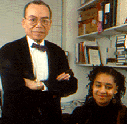
The University of Chicago Magazine
April 1997

Chicago's African-American Legacy
 James Bowman and Jacqueline Stewart spoke with a virtual Who's Who of African-American alumni.
James Bowman and Jacqueline Stewart spoke with a virtual Who's Who of African-American alumni.
Though extraordinary, the story of Henry McBay, PhD'45, is also in many ways typical of African-American doctoral students who came to the University of Chicago at a time when few other predominantly white research universities welcomed them.
Before he died in June 1995, McBay--professor emeritus at Clark Atlanta University and at Morehouse College, where he taught chemistry for nearly 40 years--got a chance to tell his story for the record. He was among several Chicago alumni interviewed for the campus-based project "Standing on the Shoulders of Giants: The African-American Legacy of the University of Chicago." Directing the project is James E. Bowman, professor emeritus of pathology, who joined Chicago's faculty in 1962.
"This is one of the reasons I became involved in this project," says Bowman, "because of stories like McBay's that should not be forgotten." Born in an impoverished Texas community to parents with little education, McBay told Bowman how his mother and father made their children study each school night from 7:30 to 10 o'clock. "And his parents would sit in the next room, supervising," Bowman recalls McBay saying, "and you would not hear a peep out of those children for the entire evening."
"That's something these students had in common," says Bowman. "Most of their families were poor, a large number were from the South, and many of the parents had not gone to college, but all of them wanted their children to succeed. They had a driving urge that, no matter what, `I was not able to do it but you will.'"
This powerful connection between parent and child is just one of the legacies symbolized in the project's title, "Standing on the Shoulders of Giants." Explains Bowman: "That particular phrase comes from Isaac Newton. After being praised for his accomplishments, he said that the only way he was able to achieve them was due to the progress others made before him. That's what many of these graduates told us in their own words. And our own hope is that documenting the lives and achievements of these alumni will provide inspiration for the next generation" of African Americans.
Bowman says it was Norma Wagoner, dean of students in the Biological Sciences Division, who first approached him about taking on the two-year-old project, which grew out of earlier attempts by the University's Coordinating Council for Minority Issues (CCMI) to compile a history of minorities on campus. The CCMI and the Biological Sciences Division both provided start-up funds for the new project, as did the Pritzker School of Medicine, the dean of students office, and the Humanities Division.
Bowman already knew much about the Chicago student and alumni experience through his wife, Barbara Taylor Bowman, AM'52. Since coming to the University in the '60s, he's also personally known every black professor teaching here-including sociologist Allison Davis, PhD'42, who joined Chicago's faculty in 1942, becoming the first African American to teach at a predominantly white university.
Although African Americans have been admitted as students from the University's beginning, it seems there were no formal policies for admitting or recruiting black scholars until much later. "It was just part of the general attitude that's always been a part of the University of Chicago," says Bowman, "that this is a community of scholars, and if you're committed to your work, committed to a high standard of excellence, then you are welcome."
Many black students came to Chicago at the encouragement of their teachers, both white and black, who were themselves University graduates. Of those students, a large percentage received aid from the Julius Rosenwald Fund, which between 1928 and 1948 gave scholarships to more than 200 African Americans attending Chicago.
Two years into his research, Bowman has talked primarily to older alumni with advanced degrees. In the future, he and Jacqueline Stewart, AM'93, a doctoral student in English and a research/administrative assistant for the project, will talk to College alumni as well as younger graduate alumni who attended in the '60s and '70s. Those alumni, says Stewart, had very different experiences than their older counterparts, who tended to ignore the racism permeating the society around them to focus on their studies.
"You could say our older alumni isolated themselves in their drive to succeed," says Stewart. At a time when only whites were allowed to live in campus dormitories, "there really weren't many social opportunities open to them, anyway," she adds. "But that didn't seem to matter to them. What did matter was that they were being given a chance to succeed."
And succeed they did, often spectacularly. Bowman ticks off names of graduates who comprise a virtual Who's Who of African Americans: attorney and former U.S. ambassador Jewel Lafontant-Mankarious, JD'46; Benjamin E. Mays, AM'25, PhD'35, former Morehouse College president and mentor to Martin Luther King, Jr.; mathematician J. Ernest Wilkins, Jr., SB'40, SM'41, PhD'42; and Clifton Wharton, Jr., AM'56, PhD'58, former chancellor of SUNY and the first African-American CEO of a Fortune 500 company, to name but a few.
Still others, says Stewart, didn't reach their pinnacle professionally because of prejudice in hiring. "We heard stories from alumni who wanted to pursue academic careers, but were turned down by universities saying, `We would hire you, but at this time we just can't do that.'" The alternative, teaching at historically black colleges, was welcomed by many, says Bowman, "because it enabled them to give something back to their people. Unfortunately, there were few opportunities to do research at those institutions, but their teaching was an inspiration to generations of students. And that is their legacy."
Bowman plans to widen the project's scope as it continues, examining such complex issues as the University's relationship with surrounding South Side communities; formal policies toward African Americans throughout the U of C's history; and administrative procedures and problems involving recruiting and retaining black students and faculty.
These efforts, Bowman hopes, will secure a more satisfying answer to the question posed in an old Sumerian legend: "What became of the black people of Sumer?" a traveler asked an old man. "Ah," the old man sighed. "They lost their history, so they died."
"Our hope," says Bowman, "is that this project will ensure that African Americans' important contributions to this University's history will not meet a similar fate."--T.A.O.
In this department:
Also in the Journal:
Plus items For the Record.
Go to:
- INVESTIGATIONS
- CHICAGO JOURNAL
- EVENTS
- LETTERS
- CHICAGOPHILE
- Feature story, "Just what the doctors ordered"
- Feature story, "Top of his game"
- Special Report, "Reel scholarship"
- Feature story, "Northern exposure"
- CLASS NEWS
- DEATHS
- BOOKS BY ALUMNI
- IN THE CLUBS
Return to April 1997 Table of Contents
